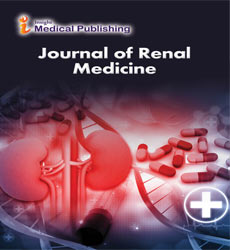The Armamentarium for Treating Diabetic Macular Edema
Emily Richard*
Department of Internal Medicine, University of Texas Health Science Center, Houston, USA
- *Corresponding Author:
- Emily Richard
Department of Internal Medicine,
University of Texas Health Science Center, Houston,
USA,
E-mail: Richard.e09@gmail.com
Received date: February 26, 2024, Manuscript No. IPJRM-24-18641; Editor assigned date: February 29, 2024, PreQC No. IPJRM-24-18641 (PQ); Reviewed date: March 14, 2024, QC No. IPJRM-24-18641; Revised date: March 21, 2024, Manuscript No. IPJRM-24-18641 (R); Published date: March 28, 2024, DOI: 10.36648/ipjrm.7.2.11
Citation: Richard E (2024) The Armamentarium for Treating Diabetic Macular Edema. Jour Ren Med Vol. 7 No.2:11.
Description
Oedema is one of the crucial elements of cardiovascular breakdown, yet the pathophysiology of oedema differs. Patients present along a range going from intense pneumonic oedema to net liquid maintenance and fringe oedema. In patients with unadulterated aspiratory oedema, the issue is one of intense haemodynamic insanity the patient doesn't have abundance liquid, however pneumonic venous tension increases to such an extent that the pace of liquid seepage into the interstitium of the lung surpasses the limit of the aspiratory lymphatics to deplete away the liquid. Alternately, in patients with fringe oedema, the issue is one of liquid maintenance. Understanding the reasons for oedema will empower clear, right administration of the condition. For patients with intense pneumonic oedema, vasodilatation is critical to diminish cardiovascular filling pressures. For patients with liquid maintenance, eliminating the liquid, utilizing either diuretics or mechanical means, is the main thought.
Angio-oedema
Innate angio-oedema is brought about by a lack of heterozygous of C1 inhibitor. This inhibitor manages a few incendiary pathways, and patients with inherited angio-oedema have discontinuous cutaneous or mucosal swellings due to an inability to control nearby creation of bradykinin. Swellings commonly develop in a few hours and continue for a couple of days. Notwithstanding orofacial angio-oedema, easy swellings influence peripheries, which causes distortion or impedance with work and different exercises of day to day living. Angiooedema influencing the gastrointestinal lot or stomach viscera makes extreme agony frequently with retching due oedematous inside check. Around 2% of swellings include the larynx and can be deadly if untreated. Around half of patients have laryngeal swellings that are possibly lethal in spite of prophylaxis. In this Class we survey the clinical elements, conclusion, and the executives of genetic angio-oedema, with explicit accentuation on the new medicines accessible for intense swellings.
The side effects of intra-oral enlarging may be gentle and gradually moderate for a few hours prior to entering a period of fast movement to asphyxiation. Patients who have had numerous non-obstructive laryngeal assaults, and doctors who are unpracticed in the administration of genetic angio-oedema, probably won't perceive the risk of intraoral expanding, which needs crisis treatment to capture movement of the assault and in some cases a troublesome intubation or crisis tracheotomy. Patients incidentally report stomach or laryngeal assaults that are quickly moderate and steep, and time from beginning to death can be basically as short as 20 min. On occasion of physical and mental pressure, during treatment with angiotensin-changing over protein inhibitors or after pharmacological or physiological openness to oestrogens, hazard of assaults is expanded. Realized hastening factors don't definitely bring about enlarging, yet rather decrease the edge for beginning of an assault. Regardless of the reversibility of the angio-oedema, its unusual nature and specifically its relationship with unpleasant circumstances brings about challenges for the patient, their family, and their managers that are proportionate to the seriousness of the issue.
Vascular Endothelial Growth Factor
Diabetic macular oedema, portrayed by exudative liquid amassing in the macula, is the most widely recognized type of sight-undermining retinopathy in individuals with diabetes. It influences one out of 15 individuals with diabetes bringing about in excess of 20 million cases around the world. Barely any epidemiological examinations have been finished to explicitly research risk factors for diabetic macular oedema, albeit poor glycaemic and pulse control are related with the presence and improvement of the issue. The pathophysiological processes start with constant hyperglycaemia, and interaction between Vascular Endothelial Growth Factor (VEGF) and fiery middle people. Harmless imaging utilizing optical soundness tomography has permitted clinicians to distinguish gentle degrees of diabetic macular oedema to screen progress and guide treatment. Albeit central or lattice laser photocoagulation was the conventional method of treatment, intraocular pharmacotherapy with hostile to VEGF specialists is presently the norm of care. In any case, these treatments are costly and asset concentrated. Arising restorative procedures incorporate further developing adequacy and length of VEGF concealment, focusing on elective pathways like irritation, and neurodegeneration, and utilizing subthreshold and designated laser treatment. Progressing examination ought to prompt enhancements in screening, determination, and the executives of diabetic macular oedema.
Central cerebral ischaemia and post-ischaemic reperfusion cause cerebral slender brokenness, bringing about oedema arrangement and haemorrhagic transformation. There are significant holes in understanding the pathophysiology, particularly with respect to early atomic members. Here, we survey physiological and atomic systems included. We reaffirm the focal job of starling's rule, which expresses that oedema still up in the air by the main impetus and the hairlike "porousness pore". We stress that the development of liquids is to a great extent driven without new use of energy by the ischaemic cerebrum. We sort out the dynamic changes in osmotic and hydrostatic conductivity of strange vessels into three stages: arrangement of ionic oedema, development of vasogenic oedema, and horrendous disappointment with haemorrhagic transformation. We recommend another hypothesis proposing that ischaemia-prompted slender brokenness can be credited to once more blend of a particular outfit of proteins that decide osmotic and water powered conductivity in starling's situation, and whose articulation is driven by an unmistakable transcriptional program.
Open Access Journals
- Aquaculture & Veterinary Science
- Chemistry & Chemical Sciences
- Clinical Sciences
- Engineering
- General Science
- Genetics & Molecular Biology
- Health Care & Nursing
- Immunology & Microbiology
- Materials Science
- Mathematics & Physics
- Medical Sciences
- Neurology & Psychiatry
- Oncology & Cancer Science
- Pharmaceutical Sciences
